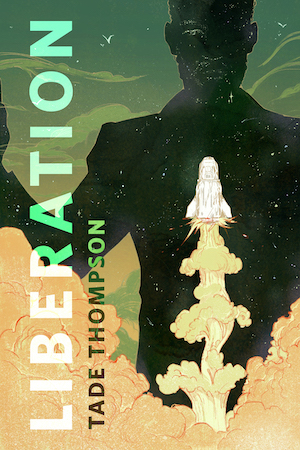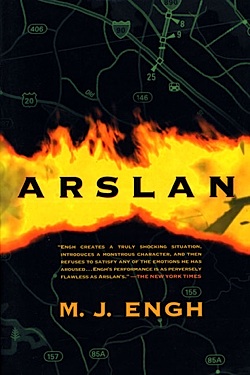M.J. Engh’s Arslan (1976) (A Wind From Bukhara in the U.K.) is one of the most compulsively readable books out there, but it’s very disturbing and very hard to talk about. There has been a coup and Arslan, the president of Turkistan, has taken over the world and is rolling into the midwest town of Kraftsville to have his victory celebration. It’s very up close and visceral and first person, and very violent. We eventually get to hear some of the backstory of how Arslan has taken over the world, but really rolling into Kraftsville is where the story starts, it’s the story of what happens afterwards—what he does with the world, to the world, after he has it.
“What happens afterwards” isn’t at all what you would expect, from the victory celebration onward. This is one of the grimmest books imaginable. There are no happy endings and not much joy along the way. It is in fact a book that makes people shudder when you mention it. But nevertheless I have read it several times, because it’s got that unputdownable quality. Engh is a terrific writer with a deft hand with vivid images. This book has great characters. But it does have some really horrible things happen, on a small scale and a large scale.
The writer Engh reminds me of most is Tiptree.
Spoilers, some distressing, and discussion of rape.
When I was floundering about trying to find a way to talk about Arslan, I found Abigail Nussbaum’s excellent discussion of the book. Now there’s nothing more discouraging than somebody else’s really good analysis of a book you’re having trouble talking about—it felt as if there was no point in saying anything because she had said it all. But then thinking about her post, I figured something out. Please go and read her whole post and then come back, because it really is a terrific post with very insightful things to say, and because I’m going to assume that you have read it and go on from there.
Nussbaum says:
I found myself, as I got further into the novel, checking and rechecking Engh’s biography to make sure I hadn’t misremembered her gender.
The invisibility of women, to the narrative as well as the three leads, is particularly startling when one considers that one of Arslan‘s most important themes is rape—the physical rapes that Arslan commits, and the metaphorical rape of the US by his invasion, which the novel returns to again and again. And yet it’s only men’s rapes that the narrative lingers over, and only through men’s eyes that the horror of rape is expressed. Women, meanwhile, simply endure, like animals.
She goes on to talk about some of the artistic reasons Engh has for writing a book about male rape, and then says the book is aimed at male readers and erases its female readers as much as it does the female characters.
Well, for one thing, it was 1976. There were far fewer female readers. But Engh herself was a woman and a reader of SF. Is it possible she felt isolated and ignored by her peers?
For another thing, I think Engh was doing something different. I think she was doing “The women men don’t see” and doing it deliberately.
When I was in Rome recently, I saw Bernini’s sculpture of the Rape of Proserpina. One of the things it made me think was that this was about rape. I don’t know how many pictures I’ve seen of rapes of Sabine women and women by gods and in all of them the women are passively laid out for the male gaze, they’re all about “Wouldn’t you like to do her, too?” Bernini, on the other hand, gives us a huge hulking horrible guy and a woman struggling who is, from most angles, only visible in her struggle—his figure eclipses everything of her but a flailing arm, or a kicking leg. You can’t tell from pictures how big it is, but he’s eight feet tall, and she’s way up in the air. His fingers are visibly bruising her leg. This is not a statue that invites you to dream about sexual participation, it’s a statue that makes you realise how much you’d struggle and how vile it would be to be grabbed against your will. There is no titillation or pandering going on at all.
Engh’s rapes are exactly like that. And the rapes of women in Arslan are indeed consequenceless, swept away, and the one woman we do see with her own agenda is murdered, and Louella is only a helpmeet, and eventually all women are sterilised and humanity is wiped out by removing fertility. I think Engh is looking at SF in the same way Bernini was looking at rapes of the gods. I think she was seeing the erasure of women and the place they had in stories, and I think she was saying “Okay, then, if they were like that and we took it to its natural conclusions, if only men were people and hurting women didn’t matter and women were only for impregnating, then what kind of world would we have?”
What we have, of course, is humanity completely wiped out, and two men struggling over constructions of masculinity and the soul of a third, who is suffering from being blamed for being a victim.
And that’s a very science fiction question to ask, as well as a very angry and political question to ask. And it’s an interestingly odd answer.
I also had a thought about Rusadan and Arslan, which I’m going to mention here because Adams and Nussbaum both cite Roman parallels, which seems to me really bizarre. Engh is indeed a classicist, but the classical parallel seems to me clearly Alexander, Alexander and Roxane, with Hunt as Hephastion/Bagoas, Alexander’s male lovers. The whole dynamic of Arslan and Rusadan is so closely modeled on Alexander and Roxane that I thought it was actually too obvious. Because Arslan is just such a conquerer as Alexander, and one of the things I see Arslan being in dialogue with is Mary Renault’s Alexander books, especially The Persian Boy, where Alexander is nice, his conquests are welcomed and the tensions of loving different people are all smoothed out. (I love The Persian Boy, incidentally. I’m not saying this to knock it at all.) As well as talking about constructions of masculinity and sexuality and complicity, she’s talking about conquest and constructions of power. Male power. If women didn’t count at all. Being conquered is like being raped. You wouldn’t like it if it happened to you.
So, Arslan. Brilliant, disturbing, intense and extremely clever.
Jo Walton is a science fiction and fantasy writer. She’s published two poetry collections and nine novels, most recently Among Others, and if you liked this post you will like it. She reads a lot, and blogs about it here regularly. She comes from Wales but lives in Montreal where the food and books are more varied.











Thank you, Jo. I missed Arslan in the 70s. I’ve ordered a copy.
I never understood what the heck Arslan was doing in Kraftsville, of all places. Not the first place I’d think to go if I took over the world. This is the kind of practical problem that can ruin a much better book than Arslan.
Rea: He was doing “History can happen to you, right here, where you are. You’re not safe by virtue of location.”
I think I’ll skip it. I didn’t know what I was getting into with Kaleidoscope Century– I’m not sure I could go through a book like that again.